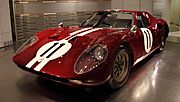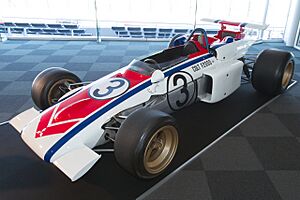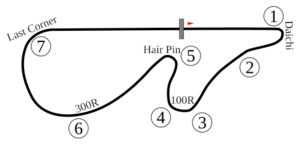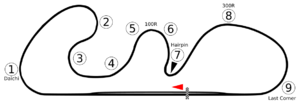Japanese Grand Prix facts for kids
| Suzuka Circuit | |
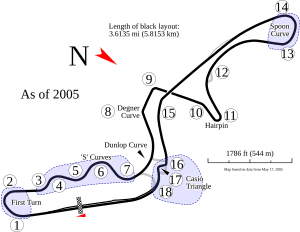 |
|
| Race information | |
|---|---|
| Number of times held | 50 |
| First held | 1963 |
| Most wins (drivers) | |
| Most wins (constructors) | |
| Circuit length | 5.807 km (3.608 mi) |
| Race length | 307.471 km (191.053 mi) |
| Laps | 53 |
| Last race (2025) | |
| Pole position | |
|
|
| Podium | |
|
|
| Fastest lap | |
|
|
The Japanese Grand Prix (Japanese: 日本グランプリ, romanized: Nihon-guranpuri) is a super exciting Formula One car race held in Japan. It's often one of the last races of the season. This means it's been the place where many World Champions were decided! In fact, 13 drivers have won their championship title at the Japanese Grand Prix. Japan was the only country in Asia to host a Formula One race for a long time, until Malaysia joined in 1999.
The first two Formula One Japanese Grands Prix in 1976 and 1977 took place at the Fuji Speedway. After that, the race wasn't held for a while. It came back in 1987 at the Suzuka Circuit. Suzuka hosted the Grand Prix for 20 years and became known as one of the toughest tracks in Formula One. In 1994 and 1995, Japan also hosted another race called the Pacific Grand Prix at the TI Circuit. This made Japan one of only a few countries to host more than one Grand Prix in the same year.
In 2007, the Grand Prix moved back to a newly designed Fuji Speedway. After another race at Fuji in 2008, it returned to Suzuka in 2009. This was part of an agreement between the owners of Fuji Speedway (Toyota) and Suzuka Circuit (Honda), who are big rivals. However, Toyota decided not to host the race at Fuji Speedway after 2009. So, the Japanese Grand Prix has been held at Suzuka every year since 2009, except for 2020 and 2021 when the races were cancelled because of the COVID-19 pandemic. The race is planned to stay at the Suzuka Circuit until at least 2029.
Contents
History of the Japanese Grand Prix
Early Races and Tracks
The very first Japanese Grand Prix was a sports car race held at the Suzuka Circuit in May 1963. Suzuka is about 80 kilometers (50 miles) southwest of Nagoya. The race was held at Suzuka again in 1964. These early races helped kick off motor racing in Japan.
For the next eight races, the Grand Prix was held at the Fuji Speedway. This track is about 66 miles (106 km) west of Tokyo. Back then, the Fuji circuit had a very fast, banked turn called Daiichi. This turn was known for many serious accidents, and it was removed in 1974. Over the years, the Japanese Grand Prix featured different types of racing, like Formula 2 and sports car races.
Formula One Era Begins
Fuji Speedway's First F1 Races
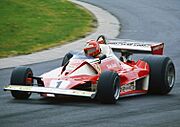
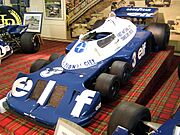
The first Formula One Japanese Grand Prix happened in 1976 at the fast Fuji Speedway. This race became famous because it decided the championship between James Hunt and Niki Lauda. It was raining very heavily, like a monsoon. Lauda, who had been in a terrible crash earlier that year, decided to stop racing because it was too dangerous. Other drivers also stopped.
The rain eventually slowed down. James Hunt, after a slow pit stop, drove incredibly hard. He moved up to 3rd place, which gave him enough points to win the championship by just one point over Lauda! American driver Mario Andretti won the race. The next year, James Hunt won the second Japanese Grand Prix. However, a serious accident happened during that race involving Gilles Villeneuve and Ronnie Peterson. Sadly, some people watching were injured. After this, the Japanese Grand Prix didn't appear on the Formula One calendar for ten years.
Suzuka Circuit Takes Over
When Formula One returned to Japan in 1987, the Grand Prix moved to the redesigned Suzuka Circuit. This track is unique because it's the only figure-eight race track in F1. It's known for being very challenging and fast, and it quickly became a favorite for drivers and fans. Suzuka has seen some of the most exciting moments in Formula One history.
The first race at Suzuka in 1987 was a classic. It decided another World Championship. Nigel Mansell crashed his car badly in practice and couldn't race, which meant his teammate Nelson Piquet won his third and final championship. Austrian driver Gerhard Berger won the race for Ferrari.
The Big Rivalry: Prost vs. Senna
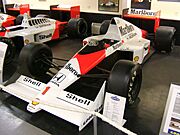
Suzuka played a huge part in the famous rivalry between French driver Alain Prost and Brazilian driver Ayrton Senna. These two were teammates at McLaren and were considered the best drivers at the time. Their battles were legendary and often very dramatic.
The 1988 race was a championship decider between Senna and Prost. Senna had a better chance to win. At the start, Senna had a very bad start, stalling his car. He dropped to 14th place, while Prost took the lead. Then it started to rain, and Senna, who was amazing in wet conditions, drove incredibly fast. He passed car after car until he caught Prost. Prost's car was having problems, and Senna passed him to win the race and his first Drivers' Championship!
The 1989 race was even more dramatic. Prost and Senna were still teammates, but their relationship was very difficult. Prost was 16 points ahead of Senna. Senna needed to win at Suzuka to have any chance of winning the championship. Senna started from pole position, much faster than Prost in qualifying.
On race day, Prost got a great start and led into the first corner. The two McLarens quickly pulled away from everyone else. On lap 47, Senna tried to pass Prost at the Casio chicane. Prost turned into Senna, and their cars crashed and got stuck together off the track. Prost got out of his car, thinking he had won the championship. But marshals pushed Senna's car back onto the track, and he managed to restart it. Even after being stopped for over 30 seconds, Senna was still leading because he and Prost had been so far ahead!
Senna's car was damaged, and he had to pit for a new nose cone. While he was in the pits, Alessandro Nannini took the lead. Senna drove furiously again, caught Nannini, and passed him to take the checkered flag. However, after the race, Senna was disqualified for cutting the chicane. This meant Nannini was given the win. Senna was very upset by this decision. Prost won the Drivers' Championship for the third time.
The 1990 race was just as controversial. Senna and Prost were again fighting for the championship, but this time Prost was at Ferrari. Senna was angry about a rule change that put his pole position on the "dirty" side of the track, making it harder to start. He said he wouldn't back down if Prost tried to overtake him at the first corner. At the start, Prost got ahead, but Senna drove into the corner and hit Prost's Ferrari. Both cars crashed out of the race. This meant Senna won his second World Drivers' Championship. The crash was very debated, but it was called a "racing incident."
Later Years at Suzuka (1991–2006)
In 1991, Senna won his third championship at Suzuka after his rival Nigel Mansell crashed. Senna even let his teammate Gerhard Berger win the race as a thank you. Later, Senna admitted that his actions in the 1990 crash were intentional because he was frustrated with how the racing rules were being handled.
In 1992, the Japanese Grand Prix didn't decide the championship, as Mansell had already won it. Riccardo Patrese won the race. In 1993, Senna won again, showing his skill in changing weather. He also had a heated argument with newcomer Eddie Irvine after the race.
By 1994, Prost had retired, and Senna had sadly passed away. That year, Damon Hill won the Japanese Grand Prix in heavy rain, beating Michael Schumacher. In 1995, Michael Schumacher won the race.
The 1996 race was the last of the year and decided the championship between Williams teammates Jacques Villeneuve and Damon Hill. Villeneuve crashed, giving the title to Damon Hill.

In 1997, Michael Schumacher won. The 1998 race was another exciting championship decider between Schumacher and Mika Häkkinen. Häkkinen won the race and his first championship after Schumacher stalled at the start and later had a tire puncture. Häkkinen then won his second championship in 1999.
Ferrari dominated the next few years. Michael Schumacher won in 2000, 2001, 2002, and 2004. His teammate Rubens Barrichello won in 2003. Schumacher won his third title in 2000, giving Ferrari their first drivers' championship in 21 years. In 2003, Schumacher won his sixth World Drivers' Championship, breaking a record. The qualifying session for the 2004 race was delayed until race day because of a typhoon.
The 2005 race was very exciting. Kimi Räikkönen won after starting from 17th place, passing Giancarlo Fisichella on the very last lap! In 2006, Michael Schumacher's engine failed, which helped Fernando Alonso win the championship.
Fuji's Brief Return and Suzuka's Comeback=

In 2006, it was announced that future races would be held at the redesigned Fuji Speedway. Many drivers and fans preferred Suzuka, so there was some concern about the move. In 2007, the race at Fuji was held in heavy rain, and Lewis Hamilton won. In 2008, Fernando Alonso won at Fuji.
In July 2009, Toyota announced that the Japanese Grand Prix would not return to Fuji Speedway after 2009. So, the race returned to Suzuka in 2010, and Suzuka has been the only host since then.
Recent Races at Suzuka
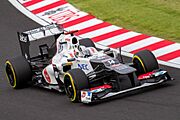
The 2009 and 2010 races were won by Sebastian Vettel for Red Bull. In 2011, Sebastian Vettel secured his second World Championship at the Japanese Grand Prix. Jenson Button won that race, wearing a special helmet to honor those affected by the 2011 Tōhoku earthquake and tsunami.
Kamui Kobayashi finished third in the 2012 Japanese Grand Prix. He was the first Japanese driver to be on the podium at a Japanese Grand Prix in 22 years! Sebastian Vettel won the 2013 race, his fourth win at Suzuka.
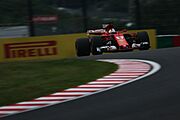
The 2014 Japanese Grand Prix was affected by a typhoon. Lewis Hamilton won the race. However, the race was sadly marked by a very serious accident. Driver Jules Bianchi crashed into a recovery crane that was on the track. He was badly injured and sadly passed away nine months later. This led to important safety changes at the track and in Formula One.
The Japanese Grand Prix contract at Suzuka has been extended several times, most recently until 2029. The 2020 and 2021 races were cancelled due to the COVID-19 pandemic.
The 2022 Japanese Grand Prix was the first at Suzuka since 2019. It had a delayed start due to heavy rain. There was also some confusion about how points were awarded, but Max Verstappen became the 2022 Formula One World Champion at this race. For the 2023 season, the points system was changed to make it clearer.
For the 2024 calendar, the Japanese Grand Prix moved from its usual September/October slot to April. This helps group races in the same part of the world together.
Popularity of the Race
Since its return to the Formula One calendar in 1987, the Japanese Grand Prix has become very popular with fans. For the 1990 race, three million people tried to get tickets for the 120,000 available seats! This was because Honda engines were winning championships, Japan had its first full-time F1 driver, Satoru Nakajima, and Ayrton Senna was incredibly popular in Japan.
After Nakajima retired and Honda left F1 for a while, interest went down. But new Japanese drivers like Takuma Sato and the return of Honda and Toyota as full teams brought the popularity back up. Honda and Toyota later left F1 again for economic reasons. Honda returned as an engine supplier in 2015 and continues to be involved with teams like Red Bull Racing.
Attendance Numbers
Here's how many people have attended the Japanese Grand Prix over the years:
|
|
|
|
|
Race Winners
Drivers with Multiple Wins
Drivers in bold are racing in Formula One right now.
A pink background means the race was not part of the Formula One World Championship.
| Wins | Driver | Years won |
|---|---|---|
| 6 | 1995, 1997, 2000, 2001, 2002, 2004 | |
| 5 | 2007, 2014, 2015, 2017, 2018 | |
| 4 | 2009, 2010, 2012, 2013 | |
| 2022, 2023, 2024, 2025 | ||
| 2 | 1966, 1969 | |
| 1969, 1973 | ||
| 1987, 1991 | ||
| 1988, 1993 | ||
| 1994, 1996 | ||
| 1998, 1999 | ||
| 2006, 2008 | ||
| Source: | ||
Teams with Multiple Wins
Teams in bold are racing in Formula One right now.
A pink background means the race was not part of the Formula One World Championship.
| Wins | Constructor | Years won |
|---|---|---|
| 9 | 1977, 1988, 1991, 1993, 1998, 1999, 2005, 2007, 2011 | |
| 8 | 2009, 2010, 2012, 2013, 2022, 2023, 2024, 2025 | |
| 7 | 1987, 1997, 2000, 2001, 2002, 2003, 2004 | |
| 6 | 2014, 2015, 2016, 2017, 2018, 2019 | |
| 3 | 1989, 1990, 1995 | |
| 1992, 1994, 1996 | ||
| 2 | 1963, 1976 | |
| 1968, 1969 | ||
| 1973, 1975 | ||
| 2006, 2008 | ||
| Source: | ||
Engine Manufacturers with Multiple Wins
Manufacturers in bold are racing in Formula One right now.
A pink background means the race was not part of the Formula One World Championship.
| Wins | Manufacturer | Years won |
|---|---|---|
| 11 | 1998, 1999, 2005, 2007, 2011, 2014, 2015, 2016, 2017, 2018, 2019 | |
| 10 | 1992, 1994, 1995, 1996, 2006, 2008, 2009, 2010, 2012, 2013 | |
| 8 | 1963, 1964, 1972, 1976, 1977, 1989, 1990, 1993 | |
| 7 | 1987, 1997, 2000, 2001, 2002, 2003, 2004 | |
| 3 | 1973, 1975, 1976 | |
| 2023, 2024, 2025 | ||
| 2 | 1988, 1991 | |
| Source: | ||
* Between 1998 and 2005 built by Ilmor
** Built by Cosworth
Winners by Year
A pink background means the race was not part of the Formula One World Championship.
See also
 In Spanish: Gran Premio de Japón para niños
In Spanish: Gran Premio de Japón para niños


